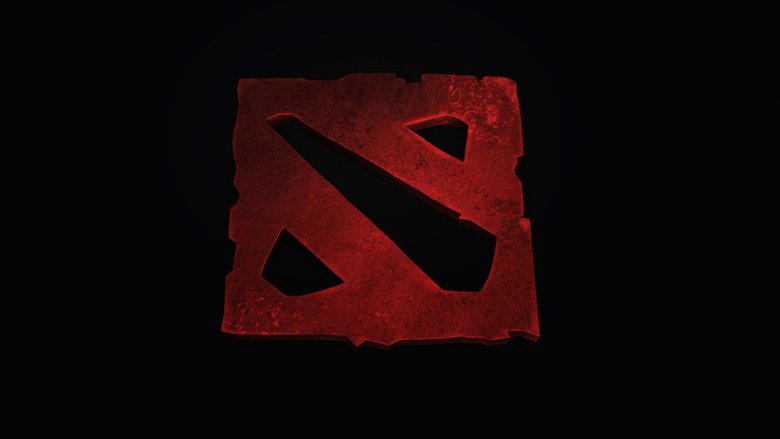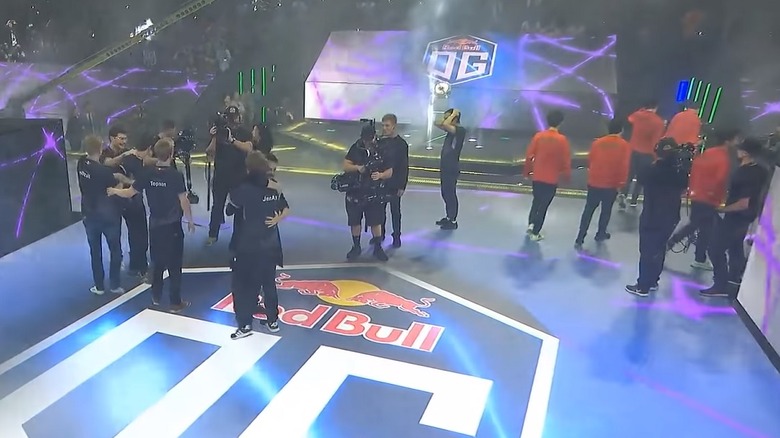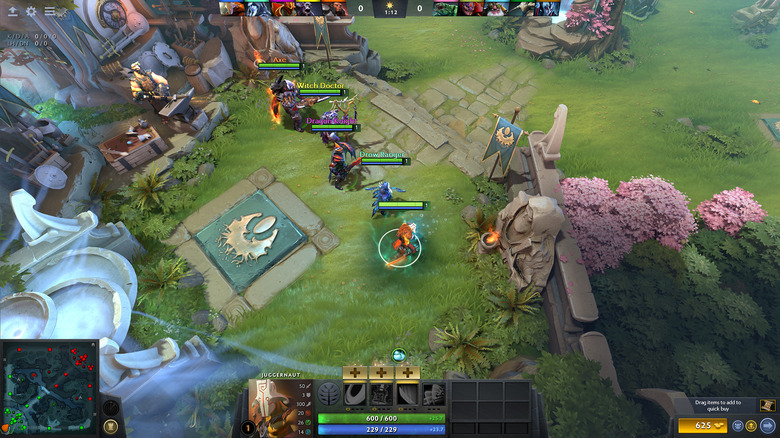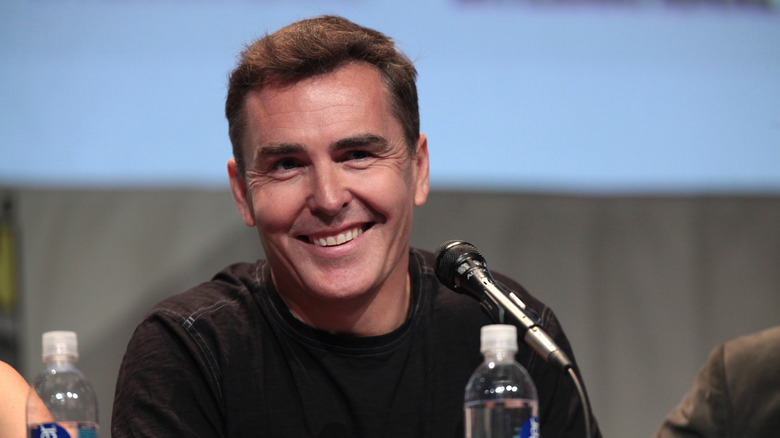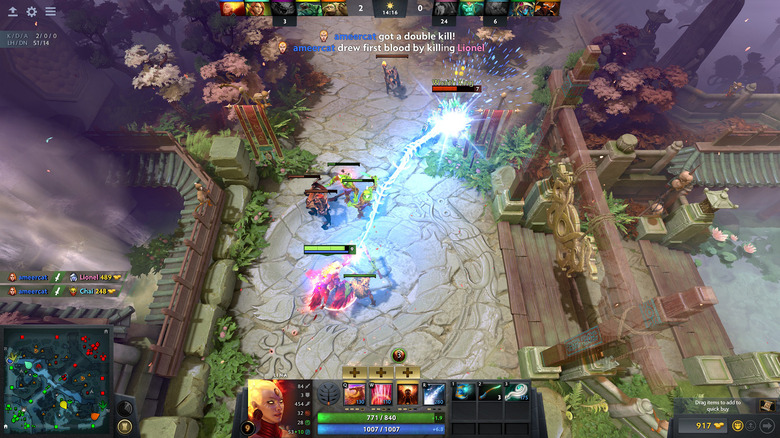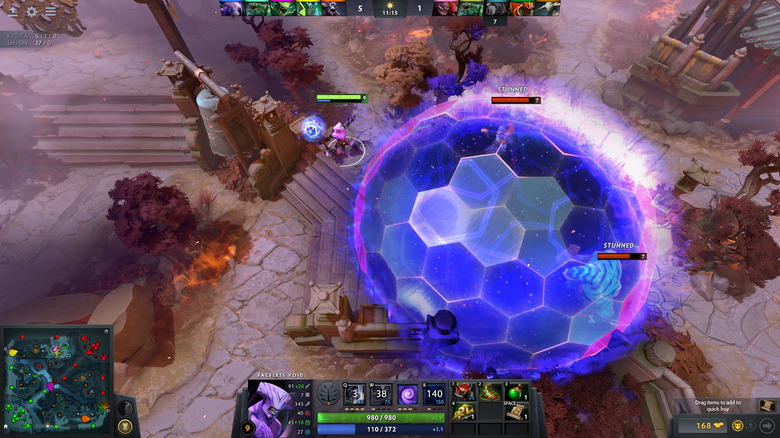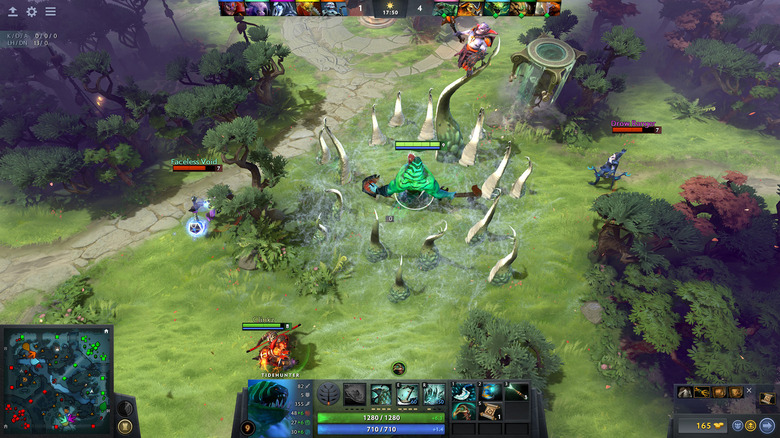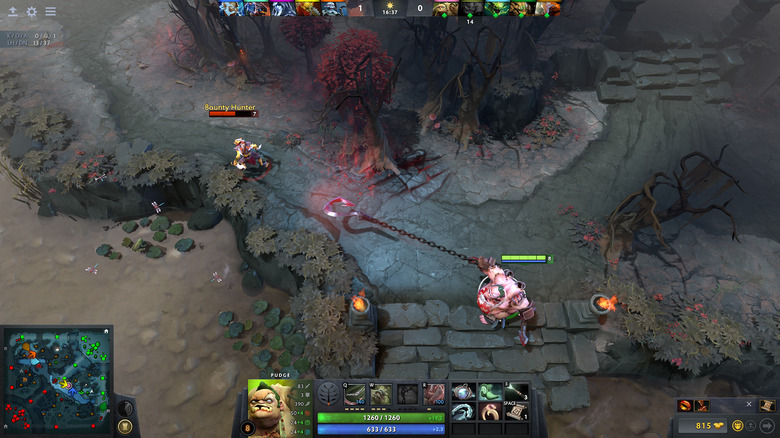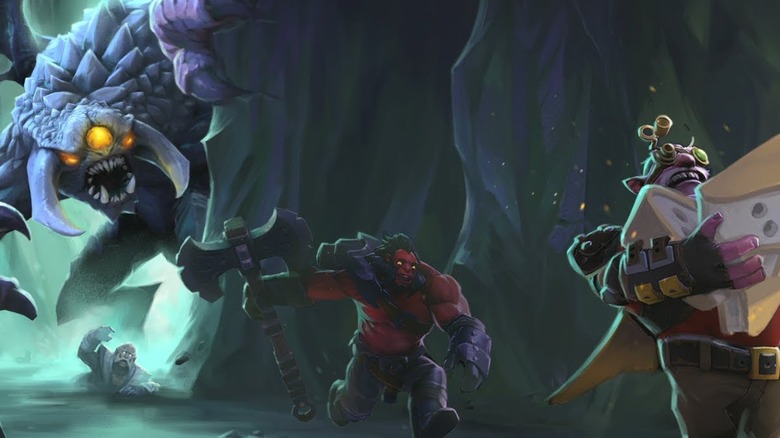The Untold Truth Of Dota 2
Ah, Dota 2. Valve Software's biggest esports title regularly sits near the top of the Steam charts, with only PUBG surpassing it on a consistent basis. Despite the fact that the game can be played entirely for free, and the map is the same every time out, Dota 2 can take hundreds of hours just to get a hold of the basics. Getting to the point where you can start to climb the leaderboards will take even more.
In his review of Dota 2, Polygon writer Arthur Geis wrote, "Closer to 5,000 hours than not in Dota 2, and I still feel some trepidation about writing a review of it. It is without a doubt the most confusing, infuriating, disorienting, unforgiving game I've ever played. I also think it might be my favorite game." It's that combination of insane difficulty, unforgettable depth, and lovable confusion that has made Dota 2 one of the biggest games in the world.
We thought we'd take a look under the hood at some of the lesser known aspects of this massive esports title, so read on. You're sure to discover something you didn't know about Dota 2.
Dota 2's largest tournament is easily the single largest payout in esports
Esports are big business in this day and age, but no game has a single tournament with as much money on the line as The International, Dota 2's premiere esports matchup. The tournament essentially breaks its own record every year, with 2018's tournament setting an esports record with a whopping payout of over $25 million. First place received over $11 million, which, for a five person team, is certainly nothing to sneeze at.
What's truly remarkable about the prize payout for the International is how little Valve actually contributes. For the 2018 tournament, Valve began with a prize pool of $1.6 million. All the rest of the prize payout came from fans purchasing a digital item, which has varied over the years. They are all essentially the same, however: a digital sticker book that unlocks rewards and allows the purchaser to interact with the tournament in all sorts of ways. Sort of a crowdsourced method of raising prize money. The International paid out up to 18th place in 2018, with that team receiving over $63,000. Nothing you could retire over, but certainly not a bad day at the office.
The original DotA was a mod of another game
Many of Valve's most successful properties come from purchasing and retooling fan-made mods. Counter-Strike was originally a mod of Half-Life, and Team Fortress was originally a Quake mod before becoming all hats and sandviches. The original DotA actually stands for Defense of the Ancients, and it was a mod for Blizzard Entertainment's Warcraft 3. The heavy-hitters developing that mod went in two different directions around the same time: Icefrog started working with Valve to create Dota 2, and Guinsoo (Steve Feak) went to Riot Games to create League of Legends.
Since Dota 2 was a sequel to a game owned by another developer, Valve had to change quite a few details to keep it recognizable without violating Blizzard's intellectual property. The two even took to the courts over the rights to the name, eventually reaching an agreement to suit both parties.
Since nearly every hero in Dota was based on the lore of Warcraft 3, practically all of them featured slight changes to not step on toes. Jin'Zakk, the Batrider became just plain old "Batrider" and such. Many items were also tied to the lore, and lost their origins in similar ways to the various heroes. It is remarkable how much Valve and Icefrog were able to keep similar to the original Dota and still manage to tell compelling stories of their own with the characters.
You could draft two different teams in Dota 2 with every character voiced by Nolan North
Dota 2 has a LOT of different characters. With each character having their own personality, background, and lore, that means the game needs a lot of voice actors. You might expect a few prolific actors to maybe voice a couple characters each, but there are actually multiple actors who are credited with bringing five or more heroes to life.
Actor Nolan North puts them all to shame. The voice of Nathan Drake is credited with voicing a whopping ten heroes in Dota 2, meaning a standard game could see each player choose a different hero, and every single one would be voiced by North.
Not that they'd be great teams, mind you; there's a few too many hard carries in North's credits. He voices (deep breath): Brewmaster, Earth Spirit, Gyrocopter, Keeper of the Light, Lone Druid, Lycan, Meepo, Ogre Magi, Shadow Demon, and Troll Warlord. No word on whether North plays Dota 2 or, if he does, which of his characters he plays best.
Dota 2 has some legendary plays that have been immortalized
All the most popular esports titles worth their salt have legendary plays: ask Street Fighter fans, and they'll tell you about Daigo's parry against Justin Wong at 2004's Evolution tournament. Counter-Strike has slews of YouTube compilations put together of pros winning thousands of dollars on the strength of one successful round.
You better believe Dota 2 has some plays that will blow your mind.
Some of the biggest moments come from the International tournament; with so much money on the line, the stakes of the biggest and best plays are amplified. Talk to Dota 2 fans about legendary plays in the game, and you'll hear tales of the "Million Dollar Dream Coil" and the "Six Million Dollar Echo Slam" (shown above). There's even a moment in Dota 2 circles simply referred to as "The Play." The best part about watching video of these plays is that you can tell how impressive they are with just the slightest understanding of how complex Dota 2 is. Watching the timing, awareness, and mechanical skill used by the world's top players is awe-inspiring, and part of why Dota 2 is such a popular esport.
The developers of the two most popular MOBAs had a rough split from one another
Fan bases are constantly bickering about which of two similar products are better, and supporters of Dota 2 are no different when it comes to its closest rival, League of Legends. Unlike many rivalries that stem from just the properties being similar, there is some literal bad blood between fans that stems all the way back to the games' creation.
The main villain of the story, if you ask Dota 2 fans, seems to be Steve "Pendragon" Mescon. The story goes something like this: Steve "Guinsoo" Feak took the helm of the original DotA mod and helped popularize it, and a big part of that popularity was due to a website run by Pendragon. When Riot Games took notice of DotA's popularity and offered Guinsoo a job to develop their MOBA title, which became League of Legends, Pendragon came aboard as well.
The problem was, he shut down DotA's largest fan website with little warning, replacing it with an ad for League of Legends. This was the first of many perceived slights that caused outcry in DotA's fan base.
Development of DotA passed to Icefrog, who continues to steer the game to this day. Many Dota 2 fans claim that Pendragon tried to "kill" Dota and still hold a grudge about the way the situation was handled.
Valve has had some serious issues with streaming rights
With giant tournaments cashing out millions of dollars to players, and with livestreaming becoming huge business over the last few years, it's understandable that game developers would want a piece of the streaming pie. That caused a substantial amount of controversy in 2017 and 2018, when an "exclusive" streaming deal with Facebook ruffled some feathers with popular casters.
The Electronic Sports League (ESL) signed an exclusive deal to stream their tournaments through Facebook. These tournaments have decent prize payouts, but the real reason teams compete is to receive qualifier points towards the International, earning a shot at Dota 2's biggest stage. Many popular Dota 2 personalities reside on Twitch, however, and streamed the tournament themselves through the Dota 2 spectator tools. ESL filed DMCA takedowns; the streamers claimed they were completely within Valve's rules for streaming matches.
IGN writes that Valve's official policy is: "anyone can broadcast any Dota game for their own audience using the in-game spectator tools. The only rule is that streamers cannot do so in a commercial way (no overlays/advertising), can't use official broadcast content (such as casting audio or camerawork), and cannot do so in a way that competes with the original stream."
For the most part, Valve's statement regarding the kerfuffle seems to support the streamers; only they can announce DMCA takedowns. However, don't expect this controversy to go away soon.
AI programs have nearly caught up to professional players
A game as complex as Dota 2, with as much situational awareness as it needs, seems like it would be practically impossible for an AI to compete with at a professional level. After all, pro players have learned how to analyze their opponents, find their weaknesses, and exploit them. It shouldn't be difficult to do that against a machine trying to learn a game as complicated as Dota 2. Right?
Well, of course you know where this is going. The machines are going to destroy us all.
The good news is this: they aren't there yet. OpenAI is the most high-profile system attempting to learn the game, and it took to the field against two pro teams at 2018's International tournament in an exhibition. Even with severe hero and item restrictions, the AI program still cannot equal the best human teams, although it came close. There's just too much critical thinking and strategy involved. For right now.
Greg Brockman, the chief researcher for OpenAI, seems confident that it won't be long until the machines are triumphant. He told Verge, "Usually we start playing teams when we're about at their level, then a week or two later we surpass them. And that has happened to us a number of times now." So, there's something to help you sleep tonight.
Dota 2's most expensive cosmetic items have inspired some major scammers
Dota 2 has some of the most expensive items on Steam's community market. For example, the "Dragonclaw Hook" regularly pulls in anywhere from $700 to $850, and it cannot be obtained outside of purchasing it from the market. Where there's big money, you know there are scammers looking to cash in on that.
The method one group used to do just that is almost admirable in how ballsy it is.
PC Gamer told the tale of a game called Climber, which sold for one dollar on Steam for a few weeks before the scam was discovered. Players could earn an in-game item for Climber that looked exactly like the Dragonclaw Hook and used the exact same description as Dota 2's valuable item. Climber even briefly changed their game icon to Dota 2's, so that people would spend hundreds of dollars on a fake, worthless item, thinking it was for their favorite game. Since game developers get a portion of sales on the community market, this could be an easy way for the "developers" of Climber to make off with some ill-gotten gains.
Luckily, Valve intervened quickly, and it seems as if only a few people were affected by the scam. Take care when purchasing an expensive item: even in the digital realm it could be a shoddy knock-off!
Dota 2 has tried to jump on the battle royale bandwagon
The battle royale genre has taken the gaming world by storm; developers are taking notice of the success of games like PUBG and Fortnite and trying to imitate that success. It's not strange that many shooters are slapping together battle royale modes to increase hype surrounding their games, but how would a mode like that ever work in something like Dota 2?
You better believe Valve has tried to figure that one out.
Valve occasionally releases new twists on Dota 2's standard gameplay, usually with the promise of special cosmetics and "limited time" engagements. With the release of 2018's International Battle Pass (the item that adds to the prize payout of the International tournament), Dota 2 received a mode called "The Underhollow," a randomly generated mission where players are forced into the center of the map, collecting random items and gearing up for one final showdown.
PC Gamer lauded the effort, but ultimately wrote that importing PUBG's structure into Dota 2's playstyle was a bit unpolished and unbalanced. Valve is notoriously secretive about their plans for Dota 2's development, so it remains to be seen if this was truly a limited-time mode or if they plan on bringing it back in the future. Iron out those kinks, and it may become the shot in the arm Dota 2 needs to retake its #1 spot from PUBG on the Steam charts.

